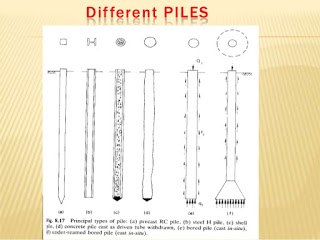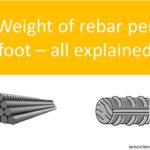A pile is a long slender foundation member, made either of timber, structural steel or concrete which might be cast-in-situ or driven and acts as a structural member to transfer the load of the structure to a required depth in deep foundations carrying a load which may be vertical or lateral or lateral plus vertical
Types of Piles Foundation
The piles may be classified as follows ;-
Classification based on the function:
The piles based upon the function or use may be classified as follows;
a. Bearing Piles:
The piles which do not support the load by themselves, but act as a medium to transmit the load from the foundation to the resisting sub-stratum, are known as a bearing piles.
b. Driven Piles
The piles which are driven in the type of soil whose strength does not increase with depth or where the rate of increase in strength with depth is very slow, are known as friction piles.
c. Compaction Piles:
the piles which are driven in granular soil with the aim of increasing the bearing capacity of the soil, are known as compaction piles.
d. Batter Piles:
The piles which are driven at an inclination to resist large horizontal or inclined forces are known as batter piles.
e. Fender Piles:
These piles are commonly used as bulk heads or as impervious cut off to reduce seepage and uplift under hydraulic structures. These piles are not meant for carrying any vertical load. The sheet piles are made of word, steel or concrete.
Classification based on materials and composition:
The piles based on the materials and composition are as follows:-
Like Us on Facebook!
a. Concrete Piles:
The concrete piles may be pre-cast piles and cast-in-situ piles. The precast concrete piles are usually reinforced concrete or pre-stressed concrete piles. These piles require space for casting and storage, more time to set and cure before installation and heavy equipment for handling and driving. The precast concrete piles are generally used for a maximum design load of about 800 kN except for large pre-stressed piles. The length of precast concrete piles varies from 4.5 m to 30 m. The pre-strssed concrete piles as compared to pre-cast and reinforced concrete piles are lesser in weight, easy to handle, have high load carrying capacity and are extremely durable.
Subscribe Us on YouTube!
Cast-in-situ concrete piles
The cast-in-situ concrete piles are casted in position inside the ground and need not to be reinforced in ordinary cases. These piles are not subjected to handling or driving stresses. The cast-in-situ concrete piles are generally used for a maximum design load of 750 kN except for compacted pedestal piles.
The cast-in-situ piles are of two types, i.e. driven piles (cased or uncased) and bored piles (pressure piles, pedestal piles and under-reamed piles). The cased cast-in-situ piles are suitable in practically all ground conditions. The common types of cased cast-in-situ piles are Raymond standard piles, and step-taper piles, Mc-Arthur Piles and sewage piles.
Raymon standard piles
The Raymon standard piles is used primarily as a friction pile. The length of pile varies from 6 to 12 m and the diameter from 40 to 60 cm at the top and 20 to 30 cm at the base. The thickness of the outer shell depends upon the pile diameter and site conditions.
Mac-Arthur cased pile
The Mac-Arthur cased pile is a pile of uniform diameter, using the corrugated steel shell which remains in place. The core and the casing are together driven into the ground to the required depth.
The sewage piles are used in some soils where driving is very hard or where it is designed to leave water tight shell from sometimes before filling the concrete.
Uncased cast-in-situ concrete piles
The uncased cast-in-situ concrete piles are cheaper but requires great skill in their construction. These piles have the advantage that they need no storage space, do not require cutting off excess lengths or building up short lengths, do not require special handling equipment and the concrete is not liable to damage from driving. The common type of uncased cast-in-situ concrete piles are simple pile, Franki Pile, vibro pile and pedestal pile.
Simplex pile
The simplex pile can be driven through soft or hard soils. In this pile, a stell tube filled with a cast iron shoe is driven into the ground upto the required depth. The reinforcement, if necessary, is put inside the tube. The concrete is then poured in to the tube, and the tube is slowely withdrawn without concrete being tamped, leaving behind the cast iron shoe.
Franki Pile
The Franki Pile has an enlarged base and a corrugated stem. This pile is more usefull where a bearing stratum of limited thickness can be reached at reasonable depth. This pile is also suited to granular soil. The pile diameter in Franki Piles vary from 500 to 600 mm, while the enlarged base may have a diameter of about 900 mm or more. The pile has a load bearing capacity of 600 to 900 KN.
Vibro piles
The Vibro piles are best suited for places where the ground is soft and offers little resistance to the flow of concrete. These piles are formed by driving a steel tube and shoe, filling with concrete and extracting the tube, using upward extracting and downward tamping blows alternatively.
Pedestal pile
The pedestal pile is used where thin bearing stratum is reached with reasonable depth. The pedestal of the pile gives the effect of spread footing on this comparatively thin bearing. The pile uses a steel tube casing and a steel core, the lower end of the core being flush with the bottom of the casing and the end made flat.
b) Steel piles.
A steel pile may be a rolled section, a fabricated shape or a piece of sheet pile. The steel piles may be either H-piles, box piles or circular tube piles. The H-Piles are suitably used in hard soil by driving to desired depth by hammering. These are generally used in retaining walls. These piles can withstand large lateral forces, requires less space for shipping and storing, and do not require special care in handling.
The box pile are generally rectangular, square or octagonal in shape. These piles consist of deep beams which offer adequate frictional resistance. These piles can also be driven in hard strata where it is not possible to drive H-piles. The shoes can be provided at its bottom. If desired.
The circular tube piles are made of seamless or welded pipes, which may be driven either closed-ended or open ended. The choice between closed-end and open end type depends upon the soil conditions at the site.
Timber Piles
The timber piles are generally square or circular in corss-section, having cast iron shoe at its bottom. The size of square and circular pile may vary between 300 to 500 mm. The length of the pile should not be more than 20 times its top width. These piles are driven with a light pile driving equipment. In order to protect the head of the pile from brooning, an iron ring is fixed at the top. The timber piles can take a maximum load of 200 kN. The best spacing of timber piles from center to center is 900 mm.
d) Composite Piles
The composite piles are those which are made of two portions of difference materials driven one above the other. The two common types of composite piles in use are timber and concrete, and steel and concrete.
3) Screw Piles
A screw pile is made of a hollow cast iron or steel shaft. The external diameter of the shaft may vary from 150 to 300 mm, which may terminate into a helix or screw base at its base. The screw pile functions more efficiently in soft clay or loose sand. These piles are screwed into the soil manually using capstan bars or by motive power. These piles can be driven without disturbing adjacent structure.
f) Disc Piles
A disc pile consist of hollow cast iron pipe with a disc or casing of enlarged size at the bottom, to enlarge the bearing area to a great extent. The diameter of the disc may vary from 0.6 m to 1.2 m. These piles are more useful in sub soil consisting of sand or sandy silt. Thes piles are used in marine structure.
b.










It is really very informative. I think you have mentioned already all the types of foundation. Thanks for this post.
It is really very informative. I think you have mentioned already all the types of foundation. Thanks for this post.
Thanks alot @Noel
Thanks alot @Noel
This comment has been removed by a blog administrator.
This comment has been removed by a blog administrator.